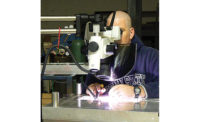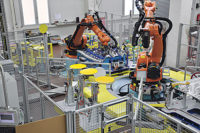Traditionally, manufacturers have relied on manual welding to assemble high-mix, low-volume products. But, more companies are turning to a new breed of flexible robots, software and controls.
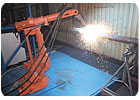
The term “small batch” means different things to different people. It depends on the industry and the application. For instance, an automotive engineer would consider a small batch to be 500 parts or less. However, five parts or fewer could mean the same thing to an aerospace engineer.
In welding circles, small batch typically refers to production environments where the parts being joined together vary in lot size, weight or physical dimensions. Equipment often must be stopped and reconfigured in between each batch, creating idle time or downtime.
“Small batch can be defined a few different ways,” says Carol Woten, process engineering manager at Genesis Systems Group. “If a customer has a low volume of parts that it will only build one time, it would be considered ‘small batch.’
“A second definition would be that the volume is low enough to be processed by one or two qualified welders, and they are able to produce those parts in a single shift or less,” adds Woten. “These parts would be built regularly, but may only be built once per week, once per month or even less often.
“A third definition would be for large parts that are made all the time, but the required weld time is very long,” Woten points out. “Examples might be a single order for parts that will never be welded again (this could require production of one day, one week or even one month); a production part that is welded once per month and takes two days to weld for each run; or one part per shift on a large construction equipment component.”
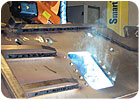
It's a Small World
No matter how it’s defined, small batch sizes are becoming more common in many industries today, as customers demand multiple product variations. Manufacturers and job shops need flexibility to easily accommodate part fluctuations, low quantities and frequent changeovers.
However, contrary to popular belief, it’s not always cost-effective to automate small-batch welding. Robots have not been widely used in the past, because they were not economical.
“The size of the part and the volume of welding done are some of the factors for determining whether or not to automate,” says Josh Williamson, robotic segment manager for North America at Fronius International GmbH. Small manufacturers and job shops have been reluctant to invest in robots for a variety of reasons, such as ”lack of knowledge, fear of investing in capital that will not function correctly, and the fact that some companies are just complacent and naturally default to their existing capabilities,” notes Williamson.
“There is work involved with bringing robotic welding into a company, but the benefits far exceed the initial transition,” claims Williamson. “Many companies just don’t grasp the concept that a little time spent up front will save them greatly for years to come.”
“Traditionally, a majority of batch welding is done manually, because the setup time is proportionally higher than the weld time,” adds Chris Anderson, welding technology leader at Motoman Robotics. “Parts in smaller batches may not warrant the expense of robotic holding or tacking fixtures.”
“To apply a robot, the historical rule of thumb is that the parts need to be repeatable within ±0.02 inch to ensure acceptable weld quality,” says Geoff Lipnevicius, operations manager in the automation division of Lincoln Electric Co., which partners with FANUC Robotics America Inc.
“Repeatable workholding is, therefore, required,” Lipnevicius points out. “However, with high-mix, low-volume, the equipment, fixturing and programming time cannot always be spread over the cost of the job, so manual or semiautomatic welding becomes the default.”
Traditionally, robots are great at repetitive welding tasks, such as assembling a continuous line of minvan bodies, but they are not as flexible as humans when it comes to moving quickly from job to job. That’s starting to change, however. A new breed of compact, flexible robots that feature large work envelopes, quick programming and user-friendly controls make it easier than ever to justify small-batch robotic welding.
For many years, the biggest obstacle to automated small-batch welding has been ease of programming, claims Efi Lebel, CEO of SmartTCP Inc., a company that has developed software that allows robots to be more flexible.
“Robots are built to be flexible, but programming is difficult and time-consuming,” Lebel points out. “With our product, it can take minutes to hours, rather than hours to days, to program tasks, depending on the application.” The software automates complex and tedious robot programming tasks.
“Automating the welding process is good practice, because it saves labor cost, solves quality issues and shortens time to market,” notes Lebel. “However, small-batch fabrication automation is not economically feasible unless you have the right technology.
“To deal with high mix, you need a machine with a large, flexible working envelope and many axes to handle a variety of part shapes and sizes,” says Lebel. “You need adaptive welding that treats each member of the small batch as a one-off, as usually parts are fitted manually and not exactly similar to each other.
“Traditional on-line and off-line programming is time-consuming and doesn’t work for a small number of parts; it is cheaper and faster to weld the few parts manually,” explains Lebel. “You need quick programming to justify robotic welding.”

Cost-Saving Benefits
Today, many small manufacturers and job shops are looking for flexible welding equipment. According to Williamson, they want “lower cost systems or welding cells that are easier to program, and are durable, faster and have a better working envelope. Also, and perhaps most importantly, they are looking for automated welding systems that can handle a wide variety of parts, both in size and geometric composition.”
Robotic welding systems can often do multiple passes on the same seam with minimal interruption. In contrast, manual welding can only complete three to four feet without stopping for the welder to change position. That’s an important consideration for small companies that must join large assemblies, such as earthmoving equipment, locomotives and ships.
Robotics can also help cost-conscious manufacturers and fabricators save money. “A robot will utilize less wire, gas and torch consumables,” notes Woten. “Overwelding of joints is common with [manual operations and companies that employ] less-qualified operators.
Efficiency comes into play, as well. “The system will not call in sick, take a lunch break or have a need for vacation,” Woten points out. “Obviously, there is some routine preventive maintenance involved in a robotic system, but overall efficiency and uptime are vastly improved over an operator.”
“[End users] are looking for a production tool that is reliable and built with existing, reputable off-the-shelf hardware,” adds Lipnevicius. “Ideally, the product should require minimal time for robot teaching and it should enable short-run, flexible production, which lowers overall part costs and reduces lead times.
“Robotics isn’t just for large fabricators,” claims Lipnevicius. “Our focus remains on helping first-time robot users to apply a production tool that pays for itself within months-certainly not beyond a year or two.”
Lipnevicius believes that the primary benefit of automating small-batch production is helping job shops and small manufacturers be more competitive in the marketplace. “It allows manufacturers to swiftly complete small-to-medium-to-large welding work and realize significant gains in consistency, quality and overall productivity,” he explains. “Automation is an ingredient for job shops to secure an advantage when competing against companies without this capability.”
Robots also help address the ongoing shortage of skilled welders. “Ten years ago, most small operations could afford the labor cost associated with doing a job manually,” says Mike Sharpe, material joining engineer at FANUC Robotics. “Today, many of those same companies are lucky if they can find one or two skilled welders.”
The United States is in the midst of a welder shortage that is expected to intensify as baby boomers age and the need for skilled labor grows. According to the American Welding Society, the average welder is in his mid-50s, and many of these people will retire within the next 10 years, creating a tremendous skills gap. In fact, the National Tooling and Machining Association claims that more than one-third of its members are turning away business due to a lack of skilled welders.
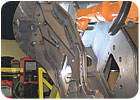
Positive Return on Investment
One company that has addressed the welder shortage by investing in small-batch automation is NPK Construction Equipment Inc., a leading manufacturer of hydraulic hammers, breaker buckets, grapples and other excavator attachments. Several years ago, the company found it challenging to rely on a manual welding process. To increase its weld capacity and save on labor costs, NPK invested in SmartTCP’s automatic welding system.
“With the company’s high-mix, low-volume production line, conventional robot programming wasn’t an option, as it was too time-consuming,” says Lebel. “SmartTCP’s hardware and software components created a system for small-batch production that allows for extremely accurate, flexible and reliable robotic welding. [Among other benefits], NPK saw the welding of one part reduced from 2.5 hours using the manual method to a 30-minute weld time using the SmartTCP system.”
Midmark Corp. is another manufacturer that has reaped the benefits of small-batch robotic welding. The company makes medical exam tables that come in a wide variety of sizes, with numerous options and configurations. It needs to produce these products in small batches to meet its target three-day lead time. However, manual welding recently became too labor-intensive.
In the past, three individuals produced these batch weldments. One operator would pull the fixtures required and load and unload them with parts, while two other operators would weld the parts in the fixture.
To automate some of its joining applications, Midmark purchased several Motoman robots, including a material-handling robot with a 165 kilogram payload that was paired with an arc-welding robot. The material-handling robot can handle a wide variety of parts fixtures.
The largest, most complex fixture combines 41 components and requires 84 welds to fabricate a scissor-lift assembly. In the past, Midmark engineers had to limit the size of fixtures because of the ergonomic risks associated with manual handling. But, the robot now allows the company to use larger fixtures that weigh up to 350 pounds.
Midmark also uses a single-station spot-welding robot cell with a fixture that can be adjusted for different configurations. “This cell provides flexibility for easy part changeover at a lower rate while the robot waits for part load-unload,” says Anderson.
The robot cell is tended by a single operator. The skilled welders were moved to other operations in the plant. “Production level is the same as before, but with less labor,” Anderson points out. “Quality is improved and eliminates the chance of missed welds.”
According to Anderson, Midmark achieved payback on its automation investment in 18 months. “The challenge of small-batch welding is wisely matching the robot and cell configuration to your requirements,” he explains. “Some operations can benefit by using the 80/20 rule to automate the higher volume product line.
“It might make sense to use a less expensive robot cell to produce subassemblies and manually finish welding larger assemblies,” Anderson points out. “On the other hand, some job shops may spend more on capability than a current project demands in the hopes that they can market it to get new business.”
One of the biggest challenges to using robots for small-batch welding is overcoming traditional perceptions and classic views of capital equipment. “Many assume that robotic welders are expensive,” says Anderson. “I have seen customers at trade shows shocked to find that robotic welding cells start at less than $100,000. We have taken these prices and used a three-year-lease rate for shift operation to calculate a $6 to $12 dollar-per-hour rate for a robotic welder.
“Classic justification for capital involves an ROI of two years,” argues Anderson. “Robots are flexible and can be redeployed, extending their life into 15 to 20 years. Extending the payback justification numbers over the life of the robot results in a seven-figure return, even with maintenance costs factored in.”
Of course, robots aren’t ideal for all welding applications. Sometimes, cycle time may actually be faster with an operator.
“This can be especially true if the programming and setup time on a small run of parts is complicated and time-consuming,” says Woten. “The number of parts required to dial in the welds may be greater than is feasible for the run of parts required.”
According to Woten, it’s always important to determine the benefit vs. the effort in robotic welding. “Some parts are not automation quality and cannot be cost-effectively made to be,” she explains. “The piece parts which make up an assembly might not be repeatable and the [end user] may not have the ability to control the design of the parts.”
The changeover time between part models may also be time-consuming. “Work balance between the operator and the robot system should be a consideration,” claims Woten. “The operator should be busy during the robot cycle, but it is important for the operator to feel as if he can beat the robot’s cycle time. This could simply amount to having the robot process the long straight welds on a large part and having the operator manually weld the tie-ins.”
Robot manufacturers are addressing those challenges with new machines aimed at small-batch welding applications. For instance, ABB Robotics recently unveiled the compact IRB 2600. It features an ultra-wide working range and a payload capacity up to 20 kilograms.
“It also offers the best accuracy and speed in its class, improving productivity through increased output, faster cycle times and lower scrap rates,” claims Mark Oxlade, arc welding manager at ABB Robotics North America. “With performance benefits like superior path accuracy and positional precision, flexible mounting options, and an increased work envelope, the IRB 2600 is particularly suited for arc welding applications.”
FANUC Robotics recently launched the ARC Mate 100iCe in Japan. It is intended for simple applications that are typically done manually, such as arc welding small workpieces. “It’s a lower-cost solution to small-batch welding that will be available in North America later this year,” says Sharpe. A

